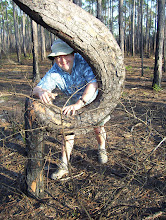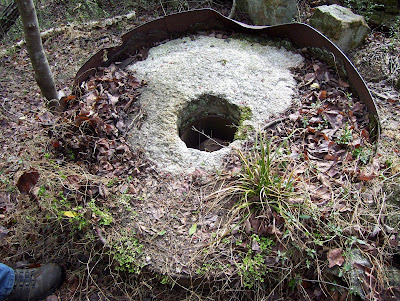 Continuing up the trail beyond the first granite pavement outcrop, we came upon the ruins of one of the mills that give Cochran Mill Park its name. The mill building itself was made of wood, and burned as a result of arson in the 1970s, though it had been starting to fall apart before then. The mill operated into the 1950s -- I have read accounts by local residents of trips to the mill to get their wheat ground into flour. One of the mill stones still remains on the site, partly covered by mosses, grasses, and fallen leaves. The stone itself is Panola granite -- we could tell right away from the large feldspar crystals dotting its surface. Local stone, it might even have been quarried right there in the park. I appreciated seeing that stone, carved meticulously out of 350-million-year-old rock, shaped into a tool for human beings to make their bread. I thought of all the ways that granite traveled through the environment -- as exposed outcrop, as soil, as home for potter's wasps, and now here, as human technology centuries old.
Continuing up the trail beyond the first granite pavement outcrop, we came upon the ruins of one of the mills that give Cochran Mill Park its name. The mill building itself was made of wood, and burned as a result of arson in the 1970s, though it had been starting to fall apart before then. The mill operated into the 1950s -- I have read accounts by local residents of trips to the mill to get their wheat ground into flour. One of the mill stones still remains on the site, partly covered by mosses, grasses, and fallen leaves. The stone itself is Panola granite -- we could tell right away from the large feldspar crystals dotting its surface. Local stone, it might even have been quarried right there in the park. I appreciated seeing that stone, carved meticulously out of 350-million-year-old rock, shaped into a tool for human beings to make their bread. I thought of all the ways that granite traveled through the environment -- as exposed outcrop, as soil, as home for potter's wasps, and now here, as human technology centuries old.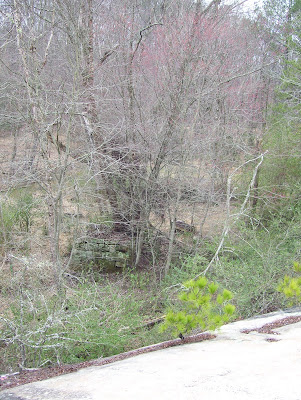
Chilled by the winter wind, we started back down the trail toward the warmth of Cochran Mill Nature Center, where we would lunch in the main gathering room, amongst the various reptiles and amphibians that call the Center home. Nearly at the end of the trail (where it meets Cochran Mill Nature Center's entrance road), I found a spider's web in the branches of a shrub that had not yet leafed out. Water droplets in the web had turned to ice in the cold morning air, and hung glittering like the jewels in Indira's Net. The spider was nowhere to be seen -- I pictured her (or him?) relaxing in a miniature lounge chair, somewhere in south Florida, sipping Bloody Marys on the rocks. I took several photographs, trying to convince my auto-focus Kodak not to ignore the web in favor of the nondescript branches in which it was nestled. At last, my camera relented, and the result is below.
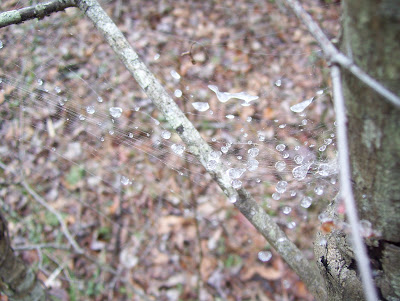 That was the last photograph I took that afternoon. The trip didn't end there, of course. The eight of us (including Julie's enthusiastic future geologist son of five years, Bruce) all enjoyed lunch together at Cochran Mill Nature Center. Then we drove out the nature center access road, passing to the right side of a series of boulders of Palmetto granite on our exit. We drove maybe an eighth of a mile south, then parked and walked in on a trail that was the original route of Cochran Mill Road, in use probably until the 1950s. Walking a short way down the flat, pine-needle-covered trail, we came to a roadcut that predates the ones along the South Fulton Parkway by perhaps a century. The rock had weathered heavily, and was mostly covered with mosses, lichens, and unlichenized algae (including an abundant free-living green alga that was, strangely enough, 1970's yellow-orange instead of green). We quickly identified the rock as highly weathered gneiss, or saprolite. Bruce enthusiastically demonstrated the auditory quality of a saprolite: a geologic hammer striking it makes a dull thud, rather than the metallic ring of "fresh" rock. We continued down the path toward the wooden pedestrian bridge over Little Bear Creek (the location of one of our school's Adopt-a-Stream sampling sites, but that is another story, to be told in November). Along our way, Julie would stop to examine rocks along the side of the trail where the cut had been made to put in the road. A few hundred feet further along from our first saprolite encounter, we stopped at a boulder of what Julie thought would turn out to be granite. Though heavily weathered, it was still possible to discern the foliation pattern in the original rock, once it was broken open. More gneiss.
That was the last photograph I took that afternoon. The trip didn't end there, of course. The eight of us (including Julie's enthusiastic future geologist son of five years, Bruce) all enjoyed lunch together at Cochran Mill Nature Center. Then we drove out the nature center access road, passing to the right side of a series of boulders of Palmetto granite on our exit. We drove maybe an eighth of a mile south, then parked and walked in on a trail that was the original route of Cochran Mill Road, in use probably until the 1950s. Walking a short way down the flat, pine-needle-covered trail, we came to a roadcut that predates the ones along the South Fulton Parkway by perhaps a century. The rock had weathered heavily, and was mostly covered with mosses, lichens, and unlichenized algae (including an abundant free-living green alga that was, strangely enough, 1970's yellow-orange instead of green). We quickly identified the rock as highly weathered gneiss, or saprolite. Bruce enthusiastically demonstrated the auditory quality of a saprolite: a geologic hammer striking it makes a dull thud, rather than the metallic ring of "fresh" rock. We continued down the path toward the wooden pedestrian bridge over Little Bear Creek (the location of one of our school's Adopt-a-Stream sampling sites, but that is another story, to be told in November). Along our way, Julie would stop to examine rocks along the side of the trail where the cut had been made to put in the road. A few hundred feet further along from our first saprolite encounter, we stopped at a boulder of what Julie thought would turn out to be granite. Though heavily weathered, it was still possible to discern the foliation pattern in the original rock, once it was broken open. More gneiss.
Still further down the trail, approaching the creek, we came to another rock, this time only a large cobblestone in size. Breaking this open, Julie was fairly confident that she was seeing granite instead. So the Contact was probably nearby, though it would elude us this time around. We did not examine any more rocks, and I was left feeling that my knowledge of the area's geology was patchy and inconclusive at best. I knew there were granitic rocks (the Palmetto granite) intruding into schists and gneisses (the Atlanta Group), but the story was still murky, the details nearly indiscernable with the passage of time. I could consult a geologic map -- perhaps even the new one -- but I expect that only months on the ground, walking the land, picking up rocks and peering at them with a hand lens, sampling them for microscopic thin sections and even x-ray diffraction analyses -- only all of this would help reveal more of the story. Or maybe, as I have come to suspect through my years as a geologist, all of that would simply lead to new and different questions to ponder.


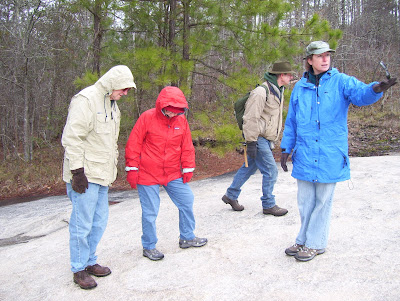
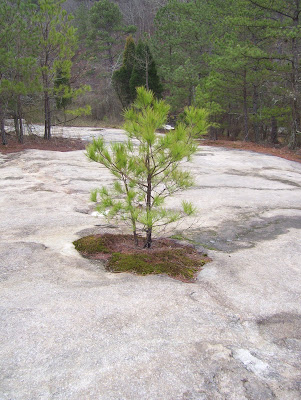

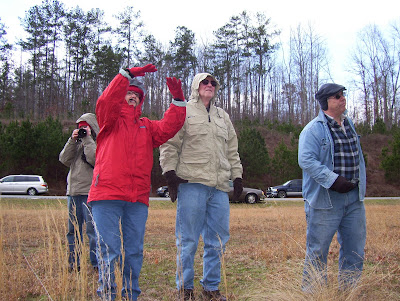
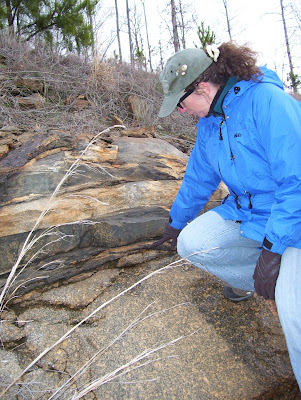
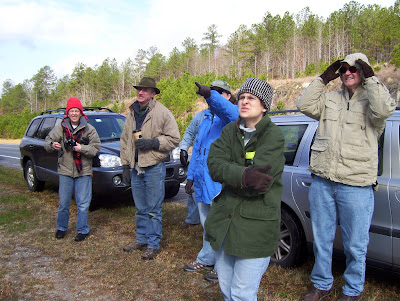

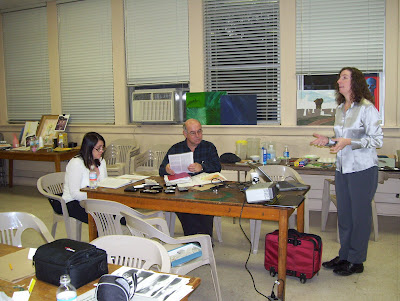
 In her carefully prepared talk (broken into sections by time participants spent examining the rock samples), Julie explained to us how the Piedmont is the most complex part of Georgia to interpret geologically. Here, we are in the middle of the Piedmont, far removed from the generally level, younger sediments of the Coastal Plain. Instead, underlying the Hill Country are metamorphic rocks, some deformed several times during various plate tectonic events, intruded by igneous rocks, some of which have themselves been deformed, perhaps even shortly after being emplaced. The result is, well, a mess. And it is a mess that very few people seem to want to tackle. Even Julie prefers to study, in her own fieldwork, Precambrian carbonate reef structures (in such places as Morocco and Siberia). Julie explained that much remains uncertain about Piedmont geology; a new digital geologic map of the Atlanta metro region was recently released, but doubts have already been raised about its accuracy.
In her carefully prepared talk (broken into sections by time participants spent examining the rock samples), Julie explained to us how the Piedmont is the most complex part of Georgia to interpret geologically. Here, we are in the middle of the Piedmont, far removed from the generally level, younger sediments of the Coastal Plain. Instead, underlying the Hill Country are metamorphic rocks, some deformed several times during various plate tectonic events, intruded by igneous rocks, some of which have themselves been deformed, perhaps even shortly after being emplaced. The result is, well, a mess. And it is a mess that very few people seem to want to tackle. Even Julie prefers to study, in her own fieldwork, Precambrian carbonate reef structures (in such places as Morocco and Siberia). Julie explained that much remains uncertain about Piedmont geology; a new digital geologic map of the Atlanta metro region was recently released, but doubts have already been raised about its accuracy. We all had a lot of fun, though, just appreciating the complexity of the story, and not worrying too much about the details. Our challenges were, first, to identify which rocks belonged to which of the three major physiographic regions of Georgia: Coastal Plain, Piedmont & Valley and Ridge, and the Blue Ridge. Later in the evening, we worked on a number of black and white rocks, some foliated (schists and gneisses), others not (granites). Wordplay possibilities abounded throughout the evening; at several points, I was sorely tempted to make a remark about not taking everything for granite -- a pun that is rather cliche, I suppose, but is nonetheless tempting to share with novice geologists.
We all had a lot of fun, though, just appreciating the complexity of the story, and not worrying too much about the details. Our challenges were, first, to identify which rocks belonged to which of the three major physiographic regions of Georgia: Coastal Plain, Piedmont & Valley and Ridge, and the Blue Ridge. Later in the evening, we worked on a number of black and white rocks, some foliated (schists and gneisses), others not (granites). Wordplay possibilities abounded throughout the evening; at several points, I was sorely tempted to make a remark about not taking everything for granite -- a pun that is rather cliche, I suppose, but is nonetheless tempting to share with novice geologists.
